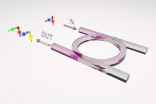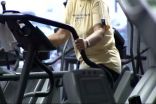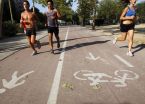(Press-News.org) Published today in PLOS ONE, the study is the first in the world to show that it is possible to predict abstract judgments from brain waves, even though people were not conscious of making such judgments.
The study also increases our understanding of impulsive behaviours and how to regulate it.
It found that researchers could predict from participants' brain activity how exciting they found a particular image to be, and whether a particular image made them think more about the future or the present.
This is true even though the brain activity was recorded before participants knew they were going to be asked to make these judgments.
Lead authors Dr Stefan Bode from the Melbourne School of Psychological Sciences and Dr Carsten Murawski from the University of Melbourne Department of Finance said these findings illustrated there was more information encoded in brain activity than previously assumed.
"We have found that brain activity when looking at images can encode judgments such as time reference, even when the viewer is not aware of making such judgments. Moreover, our results suggest that certain images can prompt a person to think about the present or the future," they said.
The authors said the results contributed to our understanding of impulsive behaviours, especially where those behaviours were caused by 'prompts' in the world around us.
"For instance, consider someone trying to quit gambling who sees a gambling advertisement on TV. Our results suggest that even if this person is trying to ignore the ad, their brain may be unconsciously processing it and making it more likely that they will relapse," he said.
The researchers used electroencephalography technology (EEG) to measure the electrical activity of people's brains while they looked at different pictures.
The pictures displayed images of food, social scenes or status symbols like cars and money. After the EEG, researchers showed participants the same pictures again and asked questions about each image, such as how exciting they thought the image was or how strongly the image made them think of either the present or the future.
A statistical 'decoding' technique was then used to predict the judgments participants made about each of the pictures from the EEG brain activity that was recorded.
Co-author Daniel Bennett said just as certain prompts might cause impulsive behaviour, images could be used to prompt people to be more patient by regulating impulse control.
"Our results suggest that prompting people with images related to the future might cause processing outside awareness that could make it easier to think about the future. In theory, this could make people less impulsive and more likely to make healthy long-term decisions. These are hypotheses we will try to test in the future," he said.
The research was done in collaboration with the University of Cologne, Germany.
INFORMATION:
The live article is available on the PLOS ONE website.
PROVIDENCE, R.I. [Brown University] — Dov Sax of Brown University and Jason Fridley of Syracuse University aren't proposing a novel idea to explain species invasiveness. In fact, Charles Darwin articulated it first. What's new about Sax and Fridley's "Evolutionary Imbalance Hypothesis" (EIH) is that they've tested it using quantifiable evidence and report in Global Ecology and Biogeography that the EIH works well.
The EIH idea is this: Species from regions with deep and diverse evolutionary histories are more likely to become successful invaders in regions with less deep, ...
Molecular studies of plants often depend on high-quantity and high-quality DNA extractions. This can be quite difficult in plants, however, due to a diversity of compounds and physical properties found in plants. "Tannins, tough fibrous material, and/or secondary compounds can interfere with DNA isolation," explains Dr. Thomas Givnish, principal investigator of a new study published by Jackson Moeller et al. in the October issue of Applications in Plant Sciences (available for free viewing at http://www.bioone.org/doi/pdf/10.3732/apps.1400048).
This is further complicated ...
WASHINGTON, Oct. 2, 2014—Commercial devices capable of encrypting information in unbreakable codes exist today, thanks to recent quantum optics advances, especially the generation of photon pairs—tiny entangled particles of light. Now, an international team of researchers led by professor Roberto Morandotti of INRS-EMT in Canada, is introducing a new method to achieve a different type of photon pair source that fits into the tiny space of a computer chip.
The team's method, which generates "mixed up" photon pairs from devices that are less than one square millimeter ...
VIDEO:
A new study suggests ibuprofen can make old lungs look young. In lab tests, daily ibuprofen lowered lung inflammation in elderly mice. The research and its implications are described by...
Click here for more information.
COLUMBUS, Ohio – New research shows that the lungs become more inflammatory with age and that ibuprofen can lower that inflammation.
In fact, immune cells from old mouse lungs fought tuberculosis bacteria as effectively as cells from young mice after ...
Grandparents can significantly influence parents' decisions to have additional children and the well-being of grandchildren, according to a recent study completed at the University of Eastern Finland.
In his PhD study, Dr Antti O. Tanskanen observed that grandparents' help with childcare and emotional support are linked to mothers' willingness to have a second or a third child. Furthermore, parents of small children who obtain support from paternal grandparents are also more likely to have additional children. The involvement of maternal grandparents in the lives of their ...
Bethesda, MD (Oct. 2, 2014) — Nonsteroidal anti-inflammatory drugs (NSAIDs) — such as ibuprofen and aspirin — increase one's risk of upper gastrointestinal bleeding. When taken in combination with other drugs, this risk is significantly higher, according to new research appearing in the October issue of Gastroenterology, the official journal of the American Gastroenterological Association.
"These findings may help clinicians tailor therapy to minimize upper gastrointestinal bleeding, and are especially valuable in elderly patients who are likely to use multiple drugs ...
The bond between humans and dogs is strong and ancient. From being the protector of the first herds in a faithful pet, dogs and people share many aspects of life. The relationship between the two species has been studied by psychologists, anthropologists, ethnologists and also by genetic and molecular biologists. In this sense, dogs are a great model for understanding the causes of human diseases, especially cancer.
Unlike other mammals used in research, dogs develop cancer spontaneously as humans do and cancer is the most common cause of death in this species. The dog ...
This news release is available in French, Spanish and German.
Low digital skills and competences among school pupils and the need to integrate effective use of information and communication technologies into teacher training are among the most pressing challenges faced by European school education today, according to a report published by the European Commission and the New Media Consortium, a US-based not-for-profit body bringing together experts in education technology. The first-ever Horizon Report Europe: 2014 Schools edition outlines the trends and technological ...
A study analysing the positive and negative effects of energy drinks on athletes has seen that, although in principle their sports performance was seen to improve by between 3% and 7%, there was also an increase in the frequency of insomnia, nervousness and the level of stimulation in the hours following competition.
The consumption of energy drinks has increased in recent years. In the case of athletes, the use of them before practising sport has also risen: more than 50% take them during training and even before competitions.
A four-year study carried out by experts ...
This news release is available in Spanish. According to a recent paper published by the researchers Aritz Urdampilleta-Otegui, PhD in Physical Education and Sports and lecturer in the Department of Physical and Sports Education of the UPV/EHU-University of the Basque Country and at the Government of the Basque Autonomous Community (region), and Saioa Gómez-Zorita, PhD in Pharmacy and Food Sciences and researcher at the UPV/EHU's Department of Pharmacy and Food Sciences, it is necessary to control the administering of drugs that interact with the foods consumed and which ...





